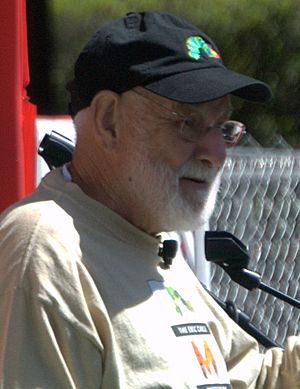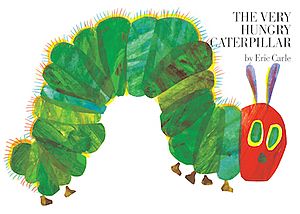Eric Carle facts for kids
Quick facts for kids
Eric Carle
|
|
|---|---|

Eric Carle speaking in Los Angeles, 2009
|
|
| Born | June 25, 1929 Syracuse, New York, U.S. |
| Died | May 23, 2021 (aged 91) Northampton, Massachusetts, U.S. |
| Occupation | Author, illustrator, designer |
| Alma mater |
|
| Genre | Children's picture books |
| Years active | 1963–2021 |
| Notable works | |
| Notable awards | Laura Ingalls Wilder Medal 2003 |
| Spouse |
Barbara Morrison
(m. 1973; died 2015) |
| Children | 2 |
Eric Carle (June 25, 1929 – May 23, 2021) was a famous German-American artist and writer. He created many beloved children's books. His most famous book, The Very Hungry Caterpillar, was first published in 1969. It has been translated into over 66 languages and sold more than 50 million copies!
Eric Carle illustrated over 70 books. He also wrote most of them himself. More than 145 million copies of his books have been sold worldwide. In 2003, he won the Children's Literature Legacy Award. This award honors writers or illustrators who have made a lasting impact on children's books in the U.S.
Contents
Eric Carle's Early Life
Eric Carle was born in Syracuse, New York, on June 25, 1929. His parents were Johanna and Erich Carle. When he was six years old, his family moved back to Stuttgart, Germany. He went to art school there and graduated from the State Academy of Fine Arts Stuttgart.
Life in Germany was hard during World War II. When Eric was 15, he was asked to dig trenches. His father was also part of the German army and was a prisoner for some time. He returned home very unwell. Eric Carle always missed the United States. He dreamed of returning one day.
In 1952, Eric Carle moved to New York City with only $40. He found a job as a graphic designer at The New York Times. He later served in the U.S. Army in Germany during the Korean War. After the army, he went back to his job at The New York Times. He later became an art director at an advertising company.
Becoming a Children's Book Author
Eric Carle's career in children's books began when educator Bill Martin Jr. saw his drawing of a red lobster. Bill Martin Jr. asked him to work together on a picture book.
Their book, Brown Bear, Brown Bear, What Do You See?, came out in 1967. It quickly became a best-seller! This started Eric Carle's journey as an illustrator. Soon, he began writing and illustrating his own stories. His first books as both author and illustrator were 1, 2, 3 to the Zoo and The Very Hungry Caterpillar, both published in 1969.
Carle's Unique Art Style
Eric Carle's artwork is made using a special technique called collage. He would paint papers with bright colors. Then, he would cut and layer these papers to create his colorful pictures. Many of his books also have fun extra features. Some have cut-out pages, like The Very Hungry Caterpillar. Others have twinkling lights, like The Very Lonely Firefly, or even the sound of a cricket, like The Very Quiet Cricket.
The ideas for his stories often came from nature. He loved remembering the walks his father would take him on through meadows and woods.
Eric Carle believed his books could help children. He said, "With many of my books I attempt to bridge the gap between the home and school." He wanted to show children that learning is "fascinating and fun." He felt that moving from home to school can be a bit scary. His books aimed to replace that fear with a positive message.
Later Life and Legacy
For over 30 years, Eric Carle and his second wife, Barbara Morrison, lived in Northampton, Massachusetts. They also had a home in Key West, Florida. Eric Carle had a son and a daughter.
Eric and Barbara Carle founded The Eric Carle Museum of Picture Book Art. This museum is in Amherst, Massachusetts. It is a special place dedicated to the art of children's books. Since it opened in 2002, over 500,000 people have visited, including many school children.
Eric Carle received many special honors from colleges and universities. In 2009, Google even honored him by asking him to design a special "Google Doodle" for their homepage. It celebrated the first day of spring and his book The Very Hungry Caterpillar.
He won many awards for his work. These include the Japan Picture Book Award and the Lifetime Achievement Award from the Society of Illustrators. In 2003, he received the Children's Literature Legacy Award. This award recognized his "visual observations of the natural world" and his creative designs. The committee praised how he used collage to create books with "luminous colors and playful designs." They also loved his interactive elements like cut-out pages and foldouts.
In 2012, a survey of School Library Journal readers voted The Very Hungry Caterpillar as the second-best children's picture book. Only Where the Wild Things Are was ranked higher.
In 2019, a type of jumping spider that looks like a caterpillar was named after Eric Carle! This was to celebrate the 50th anniversary of The Very Hungry Caterpillar and his 90th birthday.
Eric Carle passed away on May 23, 2021, at his home in Northampton, Massachusetts. He was almost 92 years old.
Selected Works

Eric Carle wrote over 70 books that sold more than 170 million copies.
- 1967, Brown Bear, Brown Bear, What Do You See? (illustrator)
- 1969, The Very Hungry Caterpillar
- 1977, The Grouchy Ladybug
- 1986, Papa, Please Get the Moon for Me
- 1986, All in a Day (Mitsumasa Anno editor)
- 1991, Polar Bear, Polar Bear, What Do You Hear? (illustrator)
- 2003, Panda Bear, Panda Bear, What Do You See? (illustrator)
- 2007, Baby Bear, Baby Bear, What Do You See? (illustrator)
See also
 In Spanish: Eric Carle para niños
In Spanish: Eric Carle para niños

